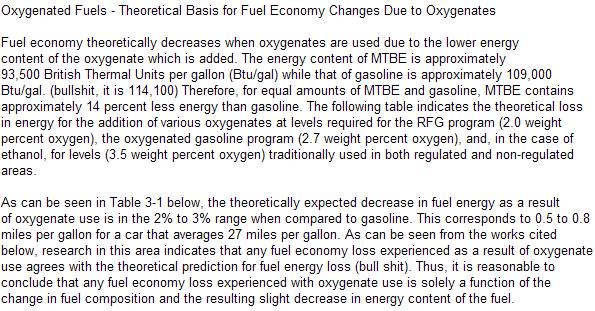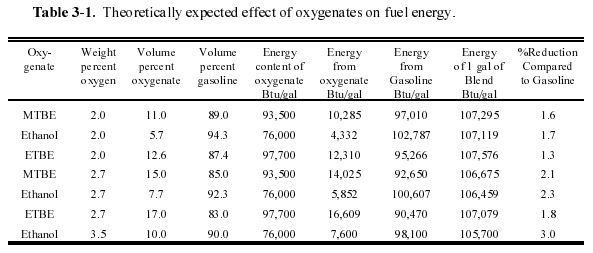|
| |
|
EPA -
Environmental Protection Agency
Fuels & Fuel Additives |
| |
|
| |
|
|
In accordance with the federal Clean Air Act (CAA), EPA
establishes fuel quality standards to help protect public health and the
environment from harmful gas and particulate matter emissions from motor
vehicles and engines.
EPA issued standards in 1973 that called for a gradual
phase down of lead to reduce the health risks from lead emissions from
gasoline. Beginning in 1989, EPA required gasoline to meet volatility
standards (in two phases) to decrease evaporative emissions of gasoline
in the summer months. Upon passage of the 1990 CAA amendments, EPA
began monitoring the winter oxygenated fuels program implemented by the
states to help control emissions of carbon monoxide. It also
established the reformulated
gasoline (RFG) program, which is designed to reduce emissions of
smog-forming and toxic pollutants. EPA also set requirements for
gasoline to be treated with detergents and deposit control additives.
More recently, EPA has set standards for low sulfur gasoline and low
sulfur diesel, which will help ensure the effectiveness of low
emission-control technologies in vehicles and reduce harmful air
pollution.
|
| |
Fuels Programs and Regulations
Resources
Staff Contact List by Topics
|
| |
E15 (a blend of gasoline and ethanol)

In response to a request by Growth Energy under section
211(f)(4) of the Clean Air Act, the Environmental Protection Agency
(EPA) has partially granted a waiver to allow fuel and fuel additive
manufacturers to introduce into commerce gasoline that contains greater
than 10 volume percent (vol%) ethanol and up to 15 vol% ethanol (E15)
for use in model year (MY) 2001 and newer light-duty motor vehicles,
subject to several conditions. On October 13, 2010, EPA granted a
partial waiver for E15 for use in MY2007 and newer light-duty vehicles
(i.e., cars, light-duty trucks and medium-duty passenger vehicles). On
January 21, 2011, EPA granted a partial waiver for E15 for use in
MY2001-2006 light-duty motor vehicles. These decisions were based on
test results provided by the U.S. Department of Energy (DOE) and other
information regarding the potential effect of E15 on vehicle emissions.
Taken together, the two actions allow, but do not require, E15 to be
introduced into commerce for use in MY2001 and newer light-duty motor
vehicles if conditions for mitigating misfueling and ensuring fuel
quality are met. EPA is in the process of completing work on regulations
that would provide a more practical means of meeting the conditions.
Prior to the distribution of E15, fuel and fuel additive
manufacturers are required to register the fuel with EPA. For more
information on fuel registration visit the Registration
and Health Effect Testing page.
There are also a number of other actions including changes to various
state and local laws that may also affect the distribution of E15.
Learn more about the Notices
and Updates and Regulations.
|
| |
Executive EPA Summary of Ethanol Complaints:
- Oxygenates have been used in gasoline since the 1970s as fuel
extenders or octane enhancers. During the 1980s, oxygenates came
into wider use as some states implemented oxygenated gasoline
programs for the control of carbon monoxide (CO) pollution. Denver,
Colorado, implemented the first oxygenated gasoline program in 1988.
- The 1990 Clean Air Act Amendments required oxygenated gasoline
programs in several areas
of the country that failed to attain the National Ambient Air
Quality Standards (NAAQS) for
CO. Many new oxygenated gasoline programs were first implemented
during the winter months
of 19921993.
- Consumers in some areas of the country expressed concerns that
oxygenated gasoline has led
to large reductions in fuel economy or poor engine performance. This
chapter examines existing
studies and literature related to fuel economy and engine
performance. Large fuel economy
losses (as high as 20%) have been claimed by some consumers.
- With regard to fuel economy, the theoretical change in fuel
economy as a result of the addition of oxygenates to gasoline is in
the range of a 2% to 3% reduction in fuel economy.
Existing research indicates that real world
fuel economy changes correspond to changes in energy content. A 2%
to 3% reduction in fuel economy equates to a less than 1 mile per
gallon change in fuel economy for a car that averages 27 miles per
gallon.
- Engine performance problems due solely to the presence of
allowable levels of oxygenates in
gasoline are not expected. Although engine
performance problems may be linked to poor
gasoline quality, the manufacturing and handling actions that cause
poor quality can occur with
either oxygenated or non-oxygenated gasoline. Many engine
performance problems are due to
factors other than gasoline and may be corrected by relatively
simple consumer actions.
-
 Download the Full Report
Download the Full Report
|
| |
| |
|
 |
| |
|
 |
| |
|
|
This is the information I have obtained. It does
not match what the EPA says. As you can see, there are drastic
differences that should in fact support the 20% fuel efficiency
reduction complaints:
 |
| |
|
| |
| EPA's
Conclusion: Non-oxygenated gasoline may not be
sold in areas covered by an oxygenated gasoline
program. Consumers, however, are not limited to purchasing gasoline only
where they
live. They can and do purchase gasoline in both covered and
non-covered areas, thereby
commingling the fuels. No unique problems have been observed from
mixtures of
oxygenated gasoline and non-oxygenated gasoline.
Oxygenates have been used in gasoline for many years. Since the
1970s, ethanol has been
added to gasoline. During the 1980s, other oxygenates, primarily MTBE,
came into
widespread use. Oxygenated gasoline blends are manufactured to meet the
same ASTM
specifications as non-oxygenated gasolines and are therefore very
similar in composition.
The fuel parameters of oxygenated gasoline are well within the
parameters of gasolines that
have been in widespread use.
Engine performance problems due solely to the presence of oxygenates in
gasoline are not
expected because of the chemical similarity of oxygenated and
non-oxygenated gasolines
and because of the demonstrated ability of in-use engines to accommodate
the relatively
minor differences.
Consumer concerns about large reductions in fuel economy are not
supported by numerous
laboratory and on-road studies. Existing research indicates that the
largest fuel economy
loss that could be attributed to the presence of oxygenates is 3%.
Consumer estimates
frequently fail to account for several critical factors that would
explain their calculation
error or provide the reason for lower fuel economy.
|
|
|
|
Gasoline Ingredient concentrations:
 |
|
|
|
|
Diesel Ingredient concentrations:
 |
| |
|
|
Kerosene Ingredient concentrations:
 |
| |
|
 Other Fuels and their ingredients
Other Fuels and their ingredients |
|
Page Last Edited -
04/03/2022

|